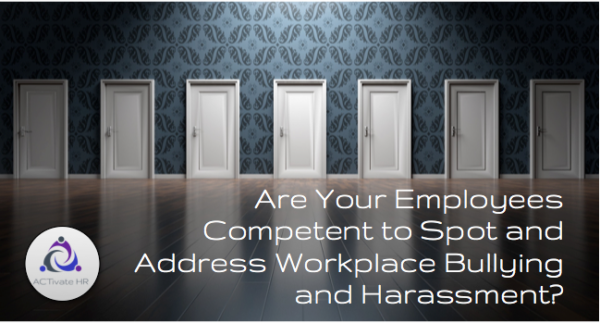Taking proactive steps to prevent workplace bullying and harassment is critical. With these steps in place, you can create a physically and psychologically safe and healthy workplace.
We have previously covered two preemptive actions companies can take for dealing with this. First, they can create solid human resources, safety and corporate policies that address workplace bullying and harassment. Second, they need to ensure all employees are aware of the policies and their roles and responsibilities in relation to the policies.
A step that’s often missed by organizations is providing training so all employees are competent to identify, prevent, and react to harassment and workplace bullying.
Addressing workplace bullying
Employees at every level of the organization need to be trained and competent to prevent, identify, and address bullying and harassing behaviours. But keep in mind, roles and responsibilities will be different depending on the employee’s role in the organization.
For example, those in leadership roles will be responsible not to engage in these behaviours themselves. They will also need to deal with situations they witness or are told about. Simply making employees aware of their accountabilities isn’t enough — employers must ensure their employees are trained to fulfill their responsibilities.
There is no one-size-fits-all to training employees. But we’ve put together the list below as a great starting point for building your training plan.
Creating a training plan
- In your new hire orientation, provide details of all policies that relate to workplace bullying and harassment. It’s also important to emphasize the employer’s commitment to a physically and psychologically safe workplace.
- Provide training to all employees on all related policies – if harassment and workplace bullying are included in multiple policies in your organization, be sure to provide training on all policies and talk about how the different policies relate to each other. The training can be face-to-face or online. For leaders, however, we recommend face-to-face training to properly address their increased responsibilities.
- Training should be ongoing. Decide on a required frequency for employee training as well as supervisor training.
- Competence is comprised of both knowing the processes and tools available as well as having the skills to carry through. Be sure to give leaders the authority to address bullying and harassing behaviour and the training they need to deal with these behaviours appropriately.
- For employees in leadership roles, don’t just provide training on the policies. You’ll also want to train your leaders on skills they need to effectively and confidently prevent and deal with harassment and bullying. Examples include training on how to coach and provide feedback as well as how to prepare for difficult conversations.
Key points to cover in your training
There are several key points to include in your training to ensure you’ve created the most comprehensive and effective plan:
-
- Details of everyone’s accountabilities. The addition of supervisor responsibilities should be highlighted as the role of supervisors is new to the legislation (previously the employer and worker were mentioned).
- Examples that employees can relate to what bullying, harassment and sexual harassment are. It is best if you can use examples from your industry and similar work environments.
- How the new definitions, responsibilities, and policies impact current policies, processes, and programs. This will be most pertinent with respect to safety programs. For example, you’ll want to highlight how the responsibility to provide a psychologically safe workplace impacts safety hazard assessments, safe work procedures, and safety incident reporting.
- What supervisors and employees should do if they witness or are told about behaviour that violates your policies.
- How to respond and report should incidents occur.
- What will happen if you are found to be in violation of the policies.
Reaping the benefits of this training
These steps won’t just make you compliant with the updated occupational health and safety legislation. They also set you up to create and sustain a culture that doesn’t tolerate bullying, harassment, or other forms of psychological harm.
We’ve also written this post where we dive into setting up processes for assessing psychological hazards at work. It also includes information for employees on how to report bullying, harassment incidents, and other psychological injuries.
This article is the fourth of an 8 part series to help you implement Bill 30 and move your company forward in creating a psychologically safe and healthy workplace. To see the previous article in the series on increasing awareness of your bullying and harassment policies click here. To read the series from the beginning and get our full checklist, click here. To see the next article in the series, click here.
ACTivate HR has years of experience helping organizations create respectful workplace policies. Our work includes creating and implementing programs and cultures to deal with incidents of bullying, harassment, and sexual harassment. Contact us today at info@activatehr.ca for help with your bullying and harassment policy, leader and employee training, and investigation needs.
Enjoyed this article? Here are three more to help you:
Acting ‘Reasonably’ in your Workplace: 5 tips to help you avoid harassment claims
The Worst Has Happened. Now What?
Effectively Investigating Workplace Bullying and Harassment Hazards and Incidents
This article was originally published on June 5, 2018, and has been updated.

